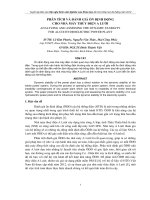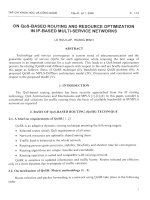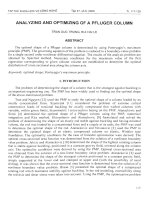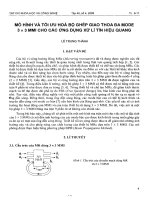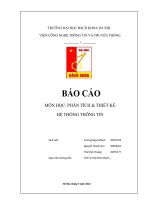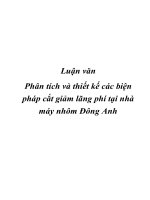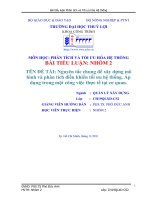Báo cáo " Phân tích và tối ưu hóa cột Pfluger" pot
Bạn đang xem bản rút gọn của tài liệu. Xem và tải ngay bản đầy đủ của tài liệu tại đây (195.97 KB, 13 trang )
TAP CHi KHOA HOC VA
CONG
NGHE Tap 47, s6 6, 2009
Tr
117-129
ANALYZING AND OPTIMIZING OF A PFLUGER COLUMN
TRAN DUC TRUNG, BUI HAI LE
ABSTRACT
The optimal shape of a Pfiuger column is determined by using Pontryagin's maximum
principle (PMP). The governing equation of the problem is reduced to a boundary-value problem
for a single second order nonlinear differential equation. The results of the analysis problem are
obtained by Spectral method. Necessary conditions for the maximum value of the first
eigenvalue corresponding to given column volume are established to determine the optimal
distribution of cross-sectional area along the column axis.
Keywords: optimal shape; Pontryagin's maximum principle.
1.
INTRODUCTION
The problem of determining the shape of a column that is the strongest against buckling is
an important engineering one. The PMP has been widely used in finding out the optimal shape
of the above-mentioned problem.
Tran and Nguyen
[12]
used the PMP to study the optimal shape of a column loaded by an
axially concentrated force. Szymczak
[11]
considered the problem of extreme critical
conservative loads of torsional buckling for axially compressed thin walled columns with
variable, within given limits, bisymmetric I cross-section basing on the PMP. Atanackovic and
Simic
[4]
determined the optimal shape of a Pfiuger column using the PMP, numerical
integration and Ritz method. Glavardanov and Atanackovic
[9]
formulated and solved the
problem of determining the shape of an elastic rod stable against buckling and having minimal
volume, the rod was loaded by a concentrated force and a couple at its ends, the PMP was used
to determine the optimal shape of the rod. Atanackovic and Novakovic
[3]
used the PMP to
determine the optimal shape of an elastic compressed column on elastic, Winkler type
foundation. The optimality conditions for the case of bimodal optimization were derived. The
optimal cross-sectional area function was determined from the solution of a nonlinear boundary
value problem. Jelicic and Atanackovic
[10]
determined the shape of the lightest rotating column
that is stable against buckling, positioned in a constant gravity field, oriented along the column
axis.
The optimality conditions were derived by using the PMP. Optimal cross-sectional area
was obtained from the solution of a non-linear boundary value problem. Atanackovic [2] used
the PMP to determine the shape of the strongest column positioned in a constant gravity field,
simply supported at the lower end and clamped at upper end (with the possibility of axial
sliding). It was shown that the cross-sectional area function is determined from the solution of a
nonlinear boundary value problem. Braun [5] presented the optimal shape of a compressed
rotating rod which maintains stability against buckling. In the rod modeling, extensibility along
the rod axis and shear stress were taken into account. Using the PMP, the optimization problem
17
is formulated with
a
fourth order boundary value problem. The optimally shaped compressed
rotating (fixed-free) rod has a finite cross-sectional area on the free end.
In this paper we determine the optimal shape of a Pfiuger column
- a
simply supported
column loaded by uniformly distributed follower type of load (see Atanackovic and Simic [4]).
Such load has the direction of the tangent to the column axis in any configuration and does not
have
a
potential, i.e.,
it is a
non-conservative load. The results
of
the analysis problem
are
obtained by Spectral method.
PMP allows estimating the maximum value of the Hamiltonian function that satisfies the
Hamiltonian adjoint equations instead of solving the minimum objective functions directly. An
analogy between adjoint variables
and
original variables holds
for
some cases. This
is an
advantageous condition to determine the maximum value of
the
Hamiltonian function.
Although PMP have been investigated, the objective function
is
still implicit, the sign of
the analogy coefficient
k
is indirectly determined and the upper and lower values of the control
variable are unbounded. The present work suggests
a
method
of
supposition
to
determine
k
directly and exactly. The Maier functional, which depends on state variables in fixed locations,
is used
as
the objective function from
a
multicriteria optimization viewpoint. The bounded
values are set up for the control variable.
The present paper is organized as follows: following the introduction section is presented
formulation
of
the problem, optimization problem
is
considered
in
section
3,
results
and
discussion are given in section 4, and final remarks are summarized in section 5.
2.
FORMULATION OF THE PROBLEM
The formulation of the problem
is
established basing on Atanackovic and Simic [4] and
Atanackovic
[1]:
Consider a column shown in Fig. 1. The column is simply supported at both ends with end
C movable. The axis of the column
is
initially straight and the column
is
loaded by uniformly
distributed follower type of load of constant intensity
q^.
We shall assume that the column axis
has length L and that it is inextensible.
Let x-B-y be a Cartesian coordinate system with the origin at the point B and with the x axis
oriented along the column axis in the undeformed state. The equilibrium equations could now be
derived
dH
dV dM
,,
n
TT
•
r,
=
-q-,
— =
-q,;
=
-Fcos6'-hi/sin6*
(2.1)
dS
^'
dS
'
dS
where H and V are components of the resultant force (a force representing the influence of the
part
{S,
L] on the part [0, S) of the column) along the x
anAy
axis, respectively,
Af is
the bending
moment and 6 is the angle between the tangent to the column axis and
x
axis. Also in (2.1)
q'v
and
qy
are components of the distributed forces along the
x
and
y
axis respectively. Since the
distributed force is tangent to the column axis we have
q,=-qf^cosd;
qy=-q^sm9
(2.2)
To the system (2.1) we adjoin the following geometrical
— =
cos^;
^ =
sin^
(2.3)
dS
dS
118
and constitutive relation
(2.4)
y-i-civ
M+dM
Figure
1.
Coordinate system and load configuration
In (2.3) and (2.4) we use x and y to denote coordinates of an arbitrary point of the column
axis and
EIXo
denote the bending rigidity. The boundary conditions corresponding to the column
shown in Fig. 1 are
x(0)
= 0;
:i'(0)
= 0;
M(0)
= 0; y{L) =
Q',
M{L) =
0;
H{L)
=
0.
(2.5)
The system (2.1)—(2.5) possesses a trivial solution in which column axis remains straight,
i.e.,
Ff{S)
=
-qo{L-S)',
1^(5)
= 5;
A/(5)
= 0;
.x\^
=
S',
/(5)
= 0;
^{S)
=
0.
(2.6)
In order to formulate the minimum volume problem for the column we take the cross-
sectional
area^(^
and the second moment of inertia I{S) of the cross-section in the form
A{S)=Aoa{S)',
I{S) =
Ioa-{^
(2.7)
where
Ao
and
/o
are constants (having dimensions of area and second moment of inertia,
respectively) and a{S) is cross-sectional area function. For the case of a column with circular
cross section we have the connection between
AQ
and
/Q
given by
IQ
=
{\I4'K)A^
. Let
AH, ,
Ad
be the perturbations
of//, ,
6*defined
by
H =
lf+AH',
V=l^+AV',
M
=
Af+AM',x=x°+Ax',y=y°+Ay',
d=^+A0.
(2.8)
Then, by introducing the following dimensionless quantities
,
AHL'
AVI} AMI
,
Ax
EL Eh EL L
n
Ay
L
S
/
=
—;
X
L
qJl
EL
(2.9)
'0
^-"o
and by substituting (2.7) in (2.1) - (2.5) we arrive to the following nonlinear system of equations
describing nontrivial configuration of the column
119
h
=
-A{\-cosd);
V =
-As'md;
m
= -vcos0-\-[-/l{\-t) +
h]s\n0;
^ =
l-eos^;
•
(2.10)
;7
=
sin6';
m
2
•
where
(•)
=
d{»)/
dt.
The boundary conditions corresponding to (2.10) are
^0)
= 0;
;7(0)
= 0;
w(0)
= 0;
rj{]) =
0;
w(l)
= 0; h{\)
=
0.
(2.11)
Note that the system
(2.10)-(2.11)
has the solution
/?(/)
= 0, , 0{t) = 0 for all values of
A.
Next we linearize
(2.10)
to obtain
h^O;
v^-Ad;
ih^-v +
-X{\-t)9;
1
=
0;
(2.12)
m
9 = ^.
w
By using boundary conditions
(2.11)
in
(2.12)
we conclude that h{t) =
<^t)
= 0 and the rest
of
Eqs
(2.12) could be reduced to
rh-^
— {l-t)m =
0
(2.13)
a
subject to: .
,
w(0)
=
w(I)
= 0. ' (2.14)
The system
(2.13)-(2.14)
constitutes a spectral problem.
3.
OPTIMIZATION PROBLEM
To determine the optimal shape of the column, we will use the PMP (Geering [8]). Let us
write optimization problem as: find out a{t),
a„,„
< a{t)
<
a,Mx,
t e
[0, 1], satisfies the objective
function
G = -{\-k^j)\+k^,J =
'cmn.
(2.15)
where
X\
is the first dimensionless eigenvalue,
k^
is non-negative weight,
k;^
e
[0, 1], the
dimensionless volume of
the
column
J is
defined as
1
J=\a{t)dt
. (2.16)
0
,
The state differential equations are
120
X,
=x,
;
x,=-^{\~t)x,
(2.17J
subject to
•
x,(0)
=
X2(l)
= 0. (2.18)
TL Proposition.' with the above-mentioned suppositions, Eqs.
(2.15)
-
(2.18),
the Hamiltonian
function H is maximized, and the analogy coefficient k
betM'een
adjoint variables and original
variables
is
positive,
where:
H=-
k
-4~^{\-i)x:
a
•
k^jO
= max (in a).
(2.19)
Proof.
The first eigenvalue
A]
is here considered as a state variable. It means that the
role of/I]
is
equivalent to those of
xi
and
Xi
in the state differential equations (2.17). The volume of the
column J is also a state variable. So, the state equations
(2.17)
can be rewritten in the form
jio;
;r
'If.:
I
1 2
A
a'
J
= a
(1-Ox,
(2.20)
The objective function can be rewritten in term of the Maier's objective functional:
G
= -(l-A:,,)^(l)
+
^,,J(l)
= min. (2.21)
From the Eqs. (2.20) the Hamiltonian function //can be established in the form as follows
^ = /'.vl^'2+P.2
-^0-OA-, \ +
p,,A,+pja,
^=0.
The adjoint equations can be expressed in the following form:
a// _
A,
p I
!
i fi
OX,
Cf
p.l
dH _
dx.,
dH 1
„ ,
0/1,
a
PJ
dH_
' dJ
0
The conjugate variables
p.rP.xi^Pn^P.i
^''^
determined from the expression:
,=i
,=1
Thus
(2.22)
(2.23a)
(2.23b)
(2.23c)
(2.23d)
(2.24)
p,,
(l)^x,
(1) +
p^,
{l)Sx,
(1) +
p,,
(1)^.^
(1) + PJ
(1)^^(1)
-p,,(O)Jx,(O)-p,,(O)Jx,(O)-p„(O)^-^(0)-p,(O)<5J(0)-(l-^,,)&^(l) + /r,,(5J(l) = O
(2.25)
121
or
p,f\)Sxfl)
+
p,f\)5xf\)
+
[p,fl)-{\-
k„)] ^-^ (1)
+
[;;,
(1) +
k,,
]5J{\)
-p^,
{0)5
x,
(0)
-
p^,
{0)5
X,
{0)-p,,
{0)5A,
(0)
-
p,
{0)SJ{0)
=
0.
Hence
P.2
(1)
=
P 2
(0)
=
0;
p,,
(1)
=
1
-
k,_,;
p„
(0)
=
0;
p,
(1)
=
-k,_,;
p,
(0)
= 0
Assigning
Px\
~
~^2H
'
Px2
~ ^\H
we obtain
^\H -^JH
^7H ' ^71
^
7
(1-0^1//•
subject to
x^f^
(1)
=
x,^
(0)
=
0
.
(2.26)
(2.27)
(2.28)
(2.29)
(2.30)
It
is
seen that Eqs. (2.17) are similar in form as ones of (2.29) and the boundary conditions
(2.18)
are
also similar
in
form
as the
conditions (2.30).
As a
result,
we
reached
the
following
conclusion: the same analogy between the adjoint variables and the original variables holds, or
KX,f,
—
X,,
/OC-,,
(2.31)
The sign of
^
can be determined by integrating the Eq. (2.23c) with appropriate conditions
in
Eq.
(2.27):
\p^^dt^p,f\)~pJQ) =
\~k„=\f^^^dt>Q.
(2.32)
0
"^
0
'^
Thus,
the sign of the analogy coefficient
k
is larger than zero for the case of maximizing
X\.
It was demonstrated
by
considering the first eigenvalue
A\
as a
state variable. The Hamiltonian
function (2.22) will be maximized
if
H =
x\-\(\-t)xl
•k^jU
=
max (in
a).
(2.19)
Thus,
basing on the PMP in optimal control for above-mentioned system's first
eigenvalue,
the obtained optimal necessary conditions consist of: the state equations
(2.17),
the boundary
conditions (2.18),
the
control variable a(t)
e
fa,^,„,
a^^J
and the maximum conidition
of
the
Hamiltonian function
(2.19).
a{t)
(initial)
i :*•
Analysis module
a{t)
(new)
^
Converged
\,
1 False
<—'
Optimization module
Results
a{f),
Xx,J
Figure
2.
The general algorithm used in the present work
122
From the multicriteria optimization viewpoint, the Parcto front between the criterion
(/>.,.
J)
is build basing on the Definition 6 in Coello Coello et al. [6] (page
10):
A solution x
e Q
is said
lo be Parelo-optimal
M'ith
respect to
Q f
and only if there is no
x"
e
Q
for which v =
F(\') = (fi(\'') f(\"))
dominates u =
F(\)=(f(\) J,,(x)).
The phrase Pareto-optimcd is meant
with respect lo the entire decision variable space unless otherwise specified. In words, this
definition says that
x*
is Pareto-optimal if there exists no feasible vector x which would decrease
some criterion without causing a simultaneous increase in at least one other criterion (assuming
minimization).
4.
RESULTS AND DISCUSSION
4.1.
Validation of the model
In
order to verify results obtained in the present work, the model in Atanackovic and Simic
[4] is studied for both validation analysis and optimization problems.
4.1.1.
Analysis problem
The first eigenvalue of the studied column with constant circular cross-section was shown
in Table 1.
Table I. The first eigenvalue of the studied column
.'.
\
The first eigenvalue
X\
Methods
a{t)=\
t7(/) =
0.81051
Present 18.957240 12.453513
Atanackovic and Simic [4] 18.956266 12.452807
4.1.2.
Optimization problem
We take J = 0.81051, 0 < a{l) < co. The aim of this section is to determine the column's
optimal shape (optimal distribution of circular cross-sectional area) and maximum value of
X\
according to above input data. The
resuhs
are
shown
in Table 2 and Fig. 3.
Table 2. The maximum value of
Ai
Methods
Present 18.950876
Atanackovic and Simic [4]
18.956266
Via sections 4.1.1 and 4.1.2, it is evident that the results of the authors, those of
Atanackovic and Simic [4] are in good
agreement,
(see Atanackovic and Simic [4] to compare
the column's optimal shape).
123
C3
"cd
c
o
15
0.4
0.2
O.J
0.9
0.3
0.4 0.5 0.6 0.7
The normalized length
/
Figure 3. The column's optimal shape
4.2.
Results
and
discussion
for the
optimization problem
of
the authors
The content
of
the problem consists
in
finding
out the
changing rule
of
the circular cross-
section
a{t)
6
[amin,
<3niax],
t £
[0, 1]
which
satisfiBS
the
state differential equations (2.17);
maximizing
the
first eigenvalue
Ai;
the
total volume
J
of
the column
is
given.
We
take
Umm =
0-9;
fl™x=
1-1-Thus,
J 6
[0.9, 1.1].
4.2.1.
Optimization problem with above-mentioned input data
The results shown
in
Table
3 and Fig. 4 are the
maximum values
of
A]
{Ai^asi),
the
column's optimal
s'lape
configurations corresponding
to
five cases of J.
Table
3. The
maximum values
of
A] (Ai^axi)
corresponding
to
five
cases
of
Jin
the
section 4.2.1
"
Notation
Case la
Case
2a
Case
3a
Case
4a
Case
5a
J
1.100
(/„/,,)
1.050
1.000
0.950
0.900
(J„.i)
-^Imaxl
22.937693 (i,,,;,,)
22.817520
21.570576
18.705883
15.354985
(/l|/„„,,)
The Pareto front
or
trade-off curve which includes
the set of
points that bounds
the
bottom
of the feasible region
is
shown
in Fig. 5.
124
Where,
/Ipari
("/")
^nd Jpari
(%) are the normalized variation of the maximum value of the
first eigenvalue and the total volume, respectively.
;
100(/l,
-^^^^,),
100(J-J,
,)
/l-Parl =
,
-'Pari = ^^
2i^
•^
i(p\
-^
lm>\
^
1.05
0.95
0.9-
-r
•Case la
' Case 2a
"Case 3a
' Case 4a
"Case
5a
I I I I I
M
I I I
h
I I I
1
I
r'l
I I I
IIIIII M
I I I
M 1
I I
IIK
1 I
0.1 0.2 0.3 0.4 0.5 0.6
The
normalized
length
/
0.7 0.8 0.9
Fig.
4. The column's optimal shape configurations corresponding to five cases of
J
in the section 4.2.
4
60
i
10
20 30
40 50 60 70
Variation of
Jp^^\
, %
80 90
Figure 5. The Pareto
fi-ont
of
the
optimization problem in the section
4.2.1.
125
4.2.2. Optimization problem with above-mentioned input data and an additional constraint
The additional constraint in this section is that a{t) = 1, ?
e
[0.1, 0.2]. It means that the
distribution of the cross-sectional area along the column axis is discontinuous.
The results described in the Table 4, Fig. 5 & 6 are the maximum values of
A\
{AU^XT),
the
column's optimal shape configurations corresponding to five cases of
7and
the Pareto front.
Table 4. The maximum values of
A\
(/liniax2)
corresponding to
five
cases of J in the section 4.2.2
Notation
Case
lb
Case 2b
Case 3b
Case 4b
Case 5b
J
1.089
(7,„,2)
1.050
1
0.950
0.911
(J/„„,2)
A
1
ma\2
22.431435 (i,,,;,,)
22.386033
21.487410
18.427398
15.661187 (A„„„.2)
03
C
O
o
-o
N
o
c
H
15 1.05-
•ig.
6,
(J.
95
0.9'
111111111
11
ll
1111
•Case lb
Case 2b
•Case 3b
Case 4b
'Case
5b
I
I
I
I I I I
I
I I
I
I I I I
I
I I
I
I I I I
I
I I
I
I I I I
I
I I
II I
I I
I
I I
II I ll I
I I
M
I II
I I
II
I
I II III II I II
I I
I II
I
0.1 0.2 0.3 0.4 0.5 0.6 0.7
The normalized lensth
/
0.8 0.9
Figure 6. The column's optimal shape configurations corresponding to five cases of J in the section 4.2.
Where,
A^^a
(%)
and
Jpar2
(%)
are the normalized variation of the maximum value of the
first eigenvalue and the total volume, respectively.
Ap
lOO(^„,2-^,„ax2) , 100(J-J,„,0
•7pai2-
'\up2 ^lou'2
f up2 "^ lOM-l
126
D
o
c
o
>
100
80-
60
40
20-
0
X
' '
-
O
{A\,ipl,
Jlinrl)
1 1 1
1 1 —1
r
Ny
C
IIII
1 1
^
B
1
-
A
0 10 20 30 40 50 60 70 80
Variation of
Jpar2.
%
Figure
7.
The Pareto front of
the
optimization problem in the section 4.2.2
90
100
4.2.3. Discussion
From the Tables 3 & 4, we can see
thai
the maximum value of the first eigenvalue
A\
is
directly proportional to the value of the column's
volume
./.
It
is a sensible relation.
The
results
shown in Figs. 4 & 6 are the column's optimal shape configurations
corresponding to five cases of ./ and two cases of constraints. So, the optimization problem
could be solved for both continuous and discontinuous control variables.
The Pareto front represents the possible trade-off among different objectives {A\, J). From
the Figs. 5 & 7, we reached the following conclusion: we never have a situation in which all the
objectives can be in a best possible way satisfied simultaneously (point O). The trade-off curves
shown in Fig. 5 & 7 could be divided into three segments including AB, BC and CD
corresponding to different trade-off levels between
/l,
and J.
5.
CONCLUSION
In the present work, the problem of analyzing and optimizing of a Pfiuger column was
investigated. The main results are summarized as follows:
• Using the Maier objective functional allows solving the multi-objective optimal problem
(maximizing
A\
and minimizing J) as a problem of controlling the final state of the objective
function.
• Considering the first eigenvalue
/l|
as a state variable allows demonstrating the
Proposition of the authors.
127
• Via the Eq. (2.19), the above-mentioned, multi-objective and multi-constraint optimal
design problem could be divided into
e.xtremuin,
single-objective and single-constraint
problems.
• Via the Pareto fronts shown in the Figs. 5 & 7, we can evaluate the trade-off level
between the objectives
{A],
J).
• Using PMP shows that we can control the value of the Pfiuger column's first eigenvalue
with the bounded and unbounded control variables a{l).
• The results can be applied to determine the shape of a column that is the strongest
against buckling under some given conditions and to separate the natural frequencies from the
frequencies of excitation loads under some given conditions of a vibrating structure.
.J
REFERENCE
1.
[1]. Atanackovic, T. M. Stability Theory of Elastic Rods (World Scientific, Singapore),
1997.
2.
Atanackovic T. M. - Optimal shape of a
strxmgest
inverted
column.
Journal of
Computational and Applied Mathematics 203 (2007)
209-218.
3.
Atanackovic T. M. and Novakovic B. N. - Optimal shape of an elastic column on elastic
foundation, European Journal of Mechanics A/Solids 25 (2006)
154-165.
4.
Atanackovic T. M. and Simic S. S. - On the optimal shape of a
Pfltiger
column, European
Journal of Mechanics A/Solids 18 (1999) 903-913.
5.
Braun D. J. - On the optimal shape of
compressed
rotating rod with shear and
extensibility.
International Journal
of
Non-linear Mechanics 43 (2008)
131-139.
6. Coello Coello C. A.,
Lament
G. B., and Van Veldhuizen D. A. - Evolutionary Algorithms
for Solving
Muhi-Objective
Problems, Springer Press, New York, USA, 2007.
7.
Do. S. - Analytical Mechanics, Bachkhoa Publishing House, Hanoi, 2007 (in
Vietnamese).
8. Geering H. P. - Optimal Control with Engineering Applications, Springer Press, Berlin,
German, 200/.
9. Glavardanov V. B. and Atanackovic T. M. - Optimal shape of a twisted and compressed
rod, European Journal of Mechanics A/Solids 20 (2001) 795-809.
10.
Jelicic Z. D. and Atanackovic T. M. - Optimal shape of a vertical rotating
column.
International Journal of Non-Linear Mechanics 42 (2007) 172-179.
11.
Szymczak C. - On torsional buckling of thin walled I columns with variable
cross-section.
International Journal of Solids and Structures 19 (6) (1983)
509-518.
12.
Tran D. T. and Nguyen D. - On the optimal axial stiffness of a
column.
Journal of
Structural mechanics and Design of Structures 6 (1979) 72-74 (in Russian).
13.
Trefethen L. N. - Spectral methods in Matlab, Society for Industrial and Applied
Mathematics, USA, 2000.
- "
128
TOM TAT
Bien dang toi uu cua cot Pfiuger
dupc
xac dinh nha
nguyen
li cue dai
Pontr\agin.
Phuong
trinh
chti
dao cua bai toan duoc
rtit gpn
thanh mpt bai toan gia trj bien
ctia
phuong trinh \
i
phan
bac hai
phj
tuyen. Ket qua
ciia
bai toan phan tich nhan dupc nha phuong phap Spectral. Dieu
kien can doi voi tri rieng thtr nhat cue dai dupc
lh\k
lap
d^
xac dinh phan
b6
toi uu cua dien tich
mat cat ngang dpc theo
true ciia
cot.
Dia
chi: Nhdn bin ngdy 10 thcing 3 ndm 2009
Department of Mechanical Engineering,
Hanoi University of Technology, Hanoi, Vietnam.
129
